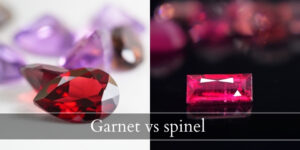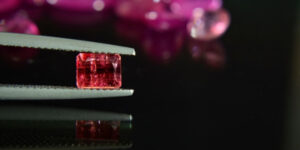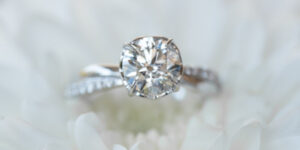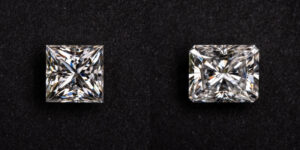Wondering whether an oval diamond is the right choice for you ? Wonder no more as we’re going to walk you through the basics of what an oval is, what you need to watch out for, and the usual price range. Read on !
What is an oval diamond ?
Oval diamonds are a type of brilliant cut diamond, in the shape of an oval, with the ends tapered but still rounded. These diamonds are the second-most popular after round brilliants, and they seem larger than a round brilliant since they carry most of their wright in their spread (including their tips).
Like the emerald cut, the oval cut is an elongated cut so it will make anyone’s fingers appear long and slender. These diamonds are very popular and you’ll often see them in more traditional engagement rings, or rings that are trying to go for a vintage look.
How did oval diamonds originate ?
Oval diamond cut is actually quite new by diamond cutting standards. It was pioneered in the later ’50s by Lazare Kaplan, which may explain why it was such a popular shape back in the 60-70s. The idea of a n oval cut was not new, but an oval cut that could sparkle like a round brilliant was new indeed.

Oval cut diamonds weren’t well cut in those times, and Kaplan managed what others couldn’t: to elongate the round brilliant in a way that would actually work and look good. So while ovals did exist before, they weren’t exactly the best looking before Kaplan took at better look at the design.
What is the best cut quality for an oval cut diamond ?
Oval cuts do not receive a cut quality grade since they are not round brilliants, but there are a few things you can look at to ensure your diamond will have optimal light performance. Things like girdle thickness, length to width ratio, culet, depth percentage are all important and a good estimate of how well the diamond will perform.
Look for a girdle thickness between very thin and slightly thick. too thin a girdle may crack or snap off, and too thick will impair light performance.
The ideal length to width ratio for an oval diamond is 1.35-1.50, and we don’t recommend getting one that is too skinny or too thick. A very long oval will gave the facets at off angles and might just need an extra couple of facets near its center, and an oval that’s too thick will look like a misshapen round.
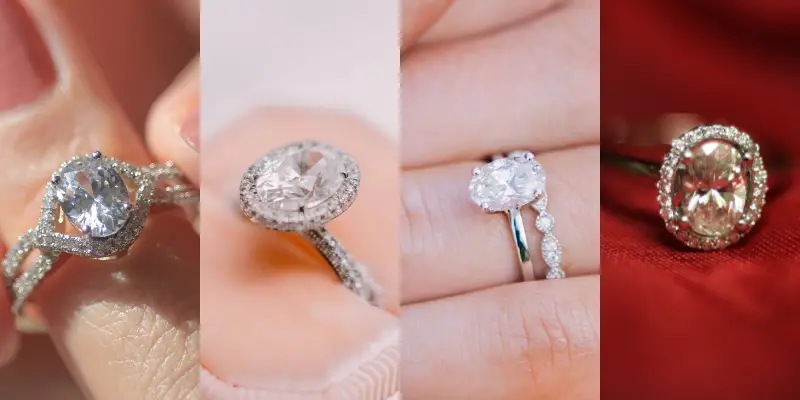
The culet is there the facets in the pavilion meet. Always look for a culet marked as closed, or pointed, or none. An open culet will leak light out of the diamond, leading to a poorer light performance.
Depth percentage is how deep (or tall) the diamond is from table to culet, compared to its total length. Look for an oval between 58-62% depth, as one deeper than that will look dull and one shallower may lack contrast and will white out.
Why do oval diamonds have a bowtie ?
You may have heard about ovals and their infamous bowties. The rumors are true and here’s why a bowtie happens. Oval cuts are basically elongated round brilliant cuts, and the facets that are at the very center of the pavilion have been widened to account for the extra length of the diamond. This area will work with less light, and this often results in the pavilion facets forming a darker or duller spot in the diamond, in the shape of a bowtie.
All ovals do this, it’s just that some show a more severe bowtie while others are not as noticeable. This is something that happens with any cut that is an elongated round brilliant, such as the marquise and the pear. Some love this bowtie effect and consider it adds charm and contrast to the diamond, while others think it detracts from the beauty of an oval.
In the end the only way to know for sure if you’d like it is to look at several ovals in person, see how they interact with the light.
Read also: Baguette Diamonds Explained
What is the best color for an oval cut diamond ?
Oval diamonds tend to show and concentrate color so it’s best to not go lower then an H in color. This happens because the oval’s ends are shallower than the center, and there are less facets, leading to color concentrating towards the tips where the facets are larger. So a J or I diamond will look warm indeed.
What is the best clarity for an oval cut diamond ?
Oval diamonds can go as low as VS2 in clarity, as long as you find one that does not have inclusions near the tips. Ovals are a brilliant cut so they will hide most inclusions, provided they are small and not close to the tips where the facets are wider and shallow.
What is the best setting for an oval cut diamond ?
Oval cut diamonds can be set in any way you like, but like most diamonds they look best in a prong setting. We recommend getting a 6 or 8 prong setting just to be sure the diamond will stay in place. One broken prong still means you have 5 or 7 extra to hold the diamond, instead of 3. These diamonds are very popular as solitaires, which works great with a prong setting.
Are oval diamonds expensive ?
Oval diamonds are more expensive than most diamonds, but less than a round brilliant. The usual price for a natural 1 carat VS2 clarity and H color oval is about $4,500. The price goes up when you get a higher clarity with the same color, such as H color but VVS2: $5,300 per carat. and again, once you bump up the color to a G but keep the higher clarity the price is around $6,000 per carat.
So oval cuts are more expensive than other cuts, such as an emerald cut or a marquise, but they are not as expensive as a round cut. This price range is the result of them being quite popular, right up there with princess and cushion cuts.

I’m the main author for jewelrymaterialguide.com. I started this site after we did tons of research before our wedding and noticed that there is information about rings, jewelry, and so on that is really hard to find on the internet.



